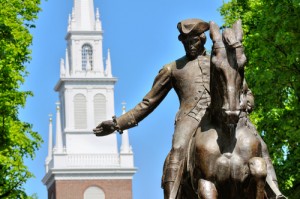
Just 13 percent of high school seniors who took the 2010 National Assessment of Educational Progress, known as the Nation’s Report Card, showed a solid grasp of American history, a new report shows.
The results, released June 14, showed the two other grade levels tested didn’t perform much better, with just 22 percent of fourth-grade students and 18 percent of eighth-graders demonstrating proficiency.
The test quizzed students on topics including colonization, the American Revolution and the Civil War, and the contemporary United States. For example, one question asked fourth-graders to name an important result of the U.S. building canals in the 1800s. Only 44 percent knew that it was increased trade among states.
“The history scores released today show that student performance is still too low,” Education Secretary Arne Duncan said in a statement. “These results tell us that, as a country, we are failing to provide children with a high-quality, well-rounded education.”
Education experts say a heavy focus on reading and math under the federal No Child Left Behind law in the last decade has led to lagging performance in other subjects such as history and science.
“We need to make sure other subjects like history, science, and the arts are not forgotten in our pursuit of the basic skills,” said Diane Ravitch, a research professor at New York University and former U.S. assistant education secretary.
A similar report issued in May revealed that fewer than one-quarter of high school seniors are proficient in civics.
Of the seven subjects on the 2010 national test, students performed the worst in U.S. history. Officials with the National Assessment Governing board, which oversees the tests, say the results aren’t comparable to the other tests, because different students take each exam in different years.
The scores on the history test did not vary remarkably from years past; in 1994, for example, 19 percent of fourth-grade students scored proficient or better in U.S. history.
More than 7,000 fourth-grade students, 11,000 eighth graders, and 12,000 high school seniors from a nationally representative sample took the test last year.
To be considered proficient, they had to get certain scores out of 500. For fourth-graders, the score was 243. Eighth-graders needed 294, and 12th graders had to get a 325.
Judy Brodigan, who was head of the elementary social studies curriculum for the Lewisville, Texas, school district for a decade, said history and social studies classes aren’t as much of a priority for school districts as math and reading. She noted that many states only test history and social studies starting in middle school, which means elementary school students don’t get the background they need in the subject.
“When the foundation isn’t built in elementary school, these students are coming to middle school lacking crucial skills,” Brodigan said. “What it means is that in what is becoming a more and more global society, American students are more and more at a disadvantage.”
Educators said history is critical to students learning how to become better citizens and understanding how the country’s political and cultural systems work. Students need to not only recognize leaders like Martin Luther King Jr. and Abraham Lincoln, but also understand why they were important to the development of the country.
“Overall the quality and success of our lives can only be enhanced by a study of our roots,” said Steven Paine, former state schools superintendent for West Virginia. “If you don’t know your past, you will not have a future.”
- ‘Buyer’s remorse’ dogging Common Core rollout - October 30, 2014
- Calif. law targets social media monitoring of students - October 2, 2014
- Elementary world language instruction - September 25, 2014


